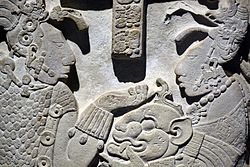 Global Information
Global InformationMaya civilization information
 | |
| Religion | Maya religion |
|---|---|
| Geographical range | Maya Region, Mesoamerica |
| Period | Mesoamerican Classic Period |
| Dates | c. 250 – c. 1697 CE |
| Type site | Uaxactun, Dzibilchaltun |
| Preceded by | Preclassic Maya |
| Cause of collapse | Spanish conquest of the Maya |


| This article is part of a series on the |
| Maya civilization |
|---|
 |
|
| History |
|
| Spanish conquest of the Maya |
|
|
The Maya civilization (/ˈmaɪə/) was a Mesoamerican civilization that existed from antiquity to the early modern period. It is known by its ancient temples and glyphs (script). The Maya script is the most sophisticated and highly developed writing system in the pre-Columbian Americas. The civilization is also noted for its art, architecture, mathematics, calendar, and astronomical system.
The Maya civilization developed in the Maya Region, an area that today comprises southeastern Mexico, all of Guatemala and Belize, and the western portions of Honduras and El Salvador. It includes the northern lowlands of the Yucatán Peninsula and the Guatemalan Highlands of the Sierra Madre, the Mexican state of Chiapas, southern Guatemala, El Salvador, and the southern lowlands of the Pacific littoral plain. Today, their descendants, known collectively as the Maya, number well over 6 million individuals, speak more than twenty-eight surviving Mayan languages, and reside in nearly the same area as their ancestors.
The Archaic period, before 2000 BC, saw the first developments in agriculture and the earliest villages. The Preclassic period (c. 2000 BC to 250 AD) saw the establishment of the first complex societies in the Maya region, and the cultivation of the staple crops of the Maya diet, including maize, beans, squashes, and chili peppers. The first Maya cities developed around 750 BC, and by 500 BC these cities possessed monumental architecture, including large temples with elaborate stucco façades. Hieroglyphic writing was being used in the Maya region by the 3rd century BC. In the Late Preclassic, a number of large cities developed in the Petén Basin, and the city of Kaminaljuyu rose to prominence in the Guatemalan Highlands. Beginning around 250 AD, the Classic period is largely defined as when the Maya were raising sculpted monuments with Long Count dates. This period saw the Maya civilization develop many city-states linked by a complex trade network. In the Maya Lowlands two great rivals, the cities of Tikal and Calakmul, became powerful. The Classic period also saw the intrusive intervention of the central Mexican city of Teotihuacan in Maya dynastic politics. In the 9th century, there was a widespread political collapse in the central Maya region, resulting in civil wars, the abandonment of cities, and a northward shift of population. The Postclassic period saw the rise of Chichen Itza in the north, and the expansion of the aggressive Kʼicheʼ kingdom in the Guatemalan Highlands. In the 16th century, the Spanish Empire colonised the Mesoamerican region, and a lengthy series of campaigns saw the fall of Nojpetén, the last Maya city, in 1697.
Rule during the Classic period centred on the concept of the "divine king", who was thought to act as a mediator between mortals and the supernatural realm. Kingship was usually (but not exclusively)[1] patrilineal, and power normally passed to the eldest son. A prospective king was expected to be a successful war leader as well as a ruler. Closed patronage systems were the dominant force in Maya politics, although how patronage affected the political makeup of a kingdom varied from city-state to city-state. By the Late Classic period, the aristocracy had grown in size, reducing the previously exclusive power of the king. The Maya developed sophisticated art forms using both perishable and non-perishable materials, including wood, jade, obsidian, ceramics, sculpted stone monuments, stucco, and finely painted murals.
Maya cities tended to expand organically. The city centers comprised ceremonial and administrative complexes, surrounded by an irregularly shaped sprawl of residential districts. Different parts of a city were often linked by causeways. Architecturally, city buildings included palaces, pyramid-temples, ceremonial ballcourts, and structures specially aligned for astronomical observation. The Maya elite were literate, and developed a complex system of hieroglyphic writing. Theirs was the most advanced writing system in the pre-Columbian Americas. The Maya recorded their history and ritual knowledge in screenfold books, of which only three uncontested examples remain, the rest having been destroyed by the Spanish. In addition, a great many examples of Maya texts can be found on stelae and ceramics. The Maya developed a highly complex series of interlocking ritual calendars, and employed mathematics that included one of the earliest known instances of the explicit zero in human history. As a part of their religion, the Maya practised human sacrifice.
- ^ The Ancient Maya Kinship System, Per Hage. The University of New Mexico 2003 [1]